2012 VOLKSWAGEN GOLF MK6 trailer
[x] Cancel search: trailerPage 102 of 516
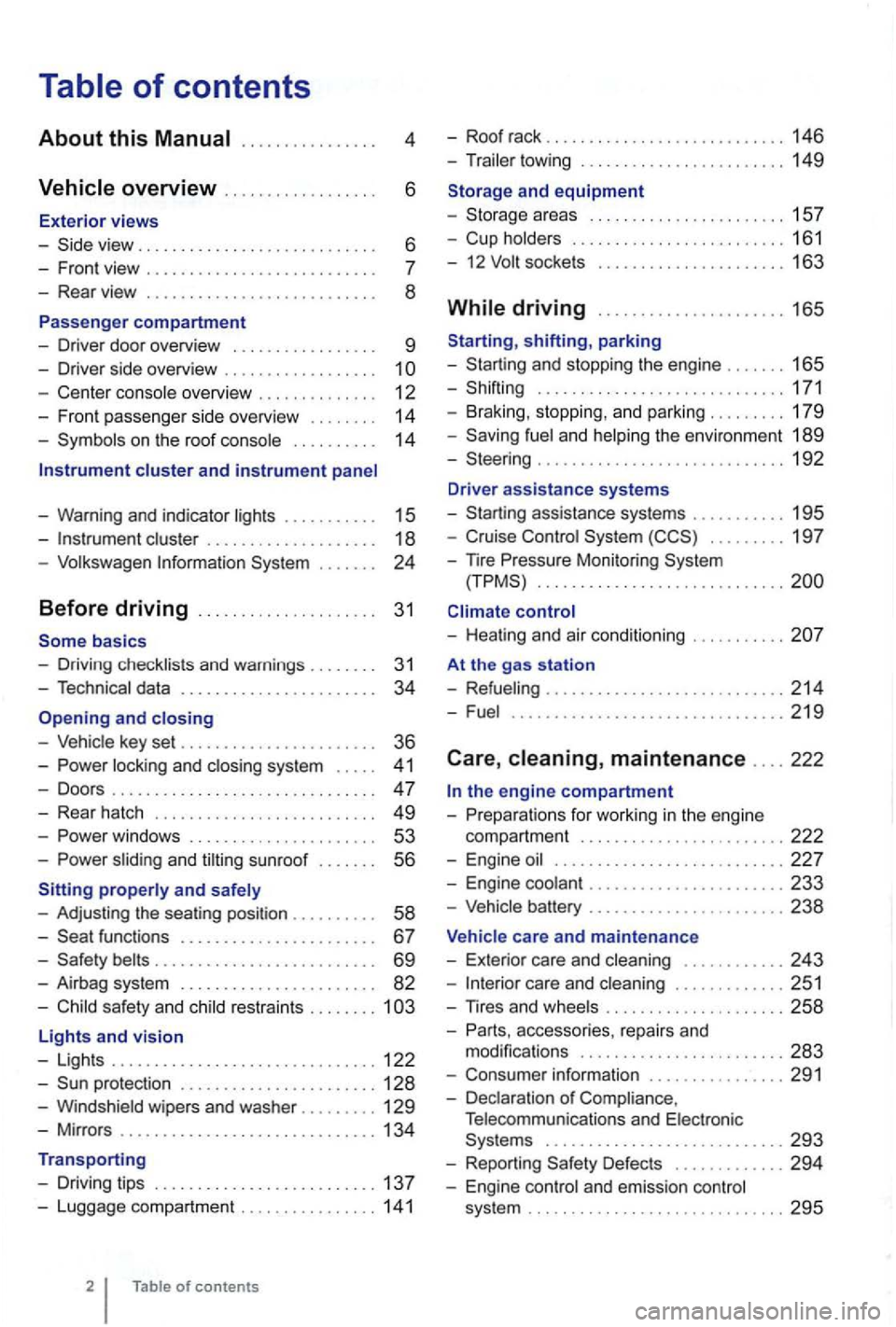
4
. . . . . . 6
- Front view . . . . . . . . . . . . . . . . . . . .
- Center console overview . . . . . . . . . . . . . . 12
- Fron t pa sse nger side overvi ew . . . . . . . .
14
- Symbo ls o n the roo f console . . . . . . . . . . 14
Instrument cluster and instrument panel
- Warning and indica tor
lights . . . . . . . . . . 15
-cluster . . . . . . . . . . . . . . . . . . . 18
-Volk swage n Information System . . .
basics
- Driv ing check lists and warnings .
....... 31
- Techn ical data . . . . . . . . . . . . . . . . . . . . . . . 34
and closing
- Vehic le key set . . . . . . . . . . . . . . . . . . . . . . . 36
-locking and closing system . . . . . 4 1
- Doo rs . . . . . . . . . . . . . . . . . . . . . . . . . . . . . . . 47
- Rear hatch . . . . . . . . . . . . . . . . . . . . . . . . . 49
-. . . 53
-s lidin g and sunroof . . . . . . . 56
properly and safely
- Adjusting the sea ting position . . . . . . .
. . 58
-functions . . . . . . . . . . . . . . . . . . . . . . 67
- Safety . . . . . . . . . . . . . . . . . . . . . . . . . . 69
- Airbag system . . . . . . . . . . . . . . . . . . . . . . . 82
-Child sa fety and child restraints ........ 1
Lights and vision
- Lights ............................... 122
-protectio n ....................... 128
-Windshield wipers and washer ......... 129
-Mir ro rs .............................. 134
Transporting
- Driving tips
.......................... 137
-Luggage compa rtment ................ 141
of contents
- Roof rack . . . . . . . . . . . . . . . . . . . . . . . . . 146
- Trailer towing ...... ............•. .... 149
1 5 7
- Cup holders
......................... 161
- 12
sockets . . . . . . . . . . . . . . . . . . . . . 163
shifting, park ing
- Sta rting and stoppin g
the engin e ....... 165
- Shifting ................... .......... 171
- Brak ing , stop ping , and park ing
......... 179
- Sav ing
fuel a nd helping the environm ent 189
-Steering ............................. 192
Driver assistance systems
- Starting assistance systems
........... 195
-Cruise Control System ......... 19 7
-
nre Mo nitori ng System .............................
control
- Healing and air cond itioning
At the gas station
- Refueling
........................ .... 214
-Fuel ...........................•.... 2 19
Care , maintenance .... 222
fo r work ing in the engin e
compartment
................... ..... 222
- Engine oil ........................... 227
- Engine coolant ....................... 233
-Vehicle battery ....................... 238
Vehicle care and maintenance
- Exteri or
care and cleaning ............ 243
-care and cleaning ............. 251
-
accesso ries, repa irs and
modi fications ........................ 283
- Consumer information ................ 291
- Declaration
of Complia nce,
T elecomm unicat ions and Electro nic
Systems
............................ 293
- Report ing Safe ty Defects ............. 294
- Engin e con trol and emission control
system .............................. 295
Page 236 of 516
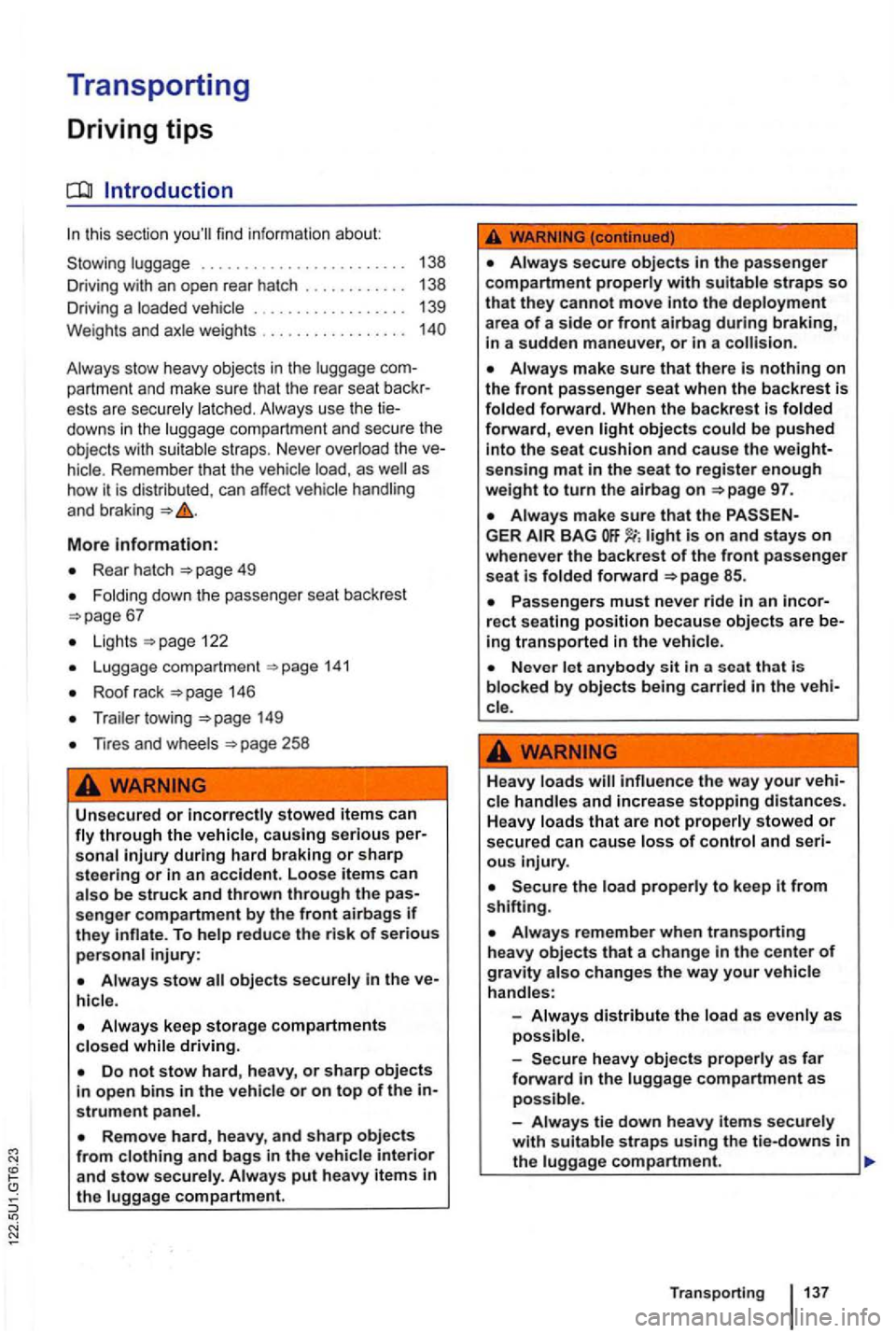
Transporting
Driving tips
this sectio n
Always stow heavy objects in the luggage partment and make sure tha t the rear seat ests are securely latched. Always use the downs in the luggage compartment and secu re th e
ob jects with suita ble straps. Neve r ove rload the
hic le . R emember that the vehicle load, as
More information:
Rear hatch 49
Folding down the passenger seat backrest
Lights page 122
Luggage compartment 141
Roof rack 146
Trailer towing 149
Tires and wheels 258
Unsec ured or incorrectly stowed items can fly through the vehicle, causing serious
senger compartment by the front airbags if they To help reduce the risk of se riou s
per sonal injury:
strument panel.
nothing on
the front passenger seat when the backrest is folded forward. When the backrest is folded
forward, even
85.
scat that is
blocked by objects being carried
H eavy loads will cle handle s and increase stopping distances.
Heavy lo ads that are not properly stowed or secured can cause loss of control and ous injury.
the luggage compartment as possible.
-
Always tie down h eavy items securely with su itabl e strap s using the tie-downs in the luggage compartment.
Tran sporting
Page 237 of 516
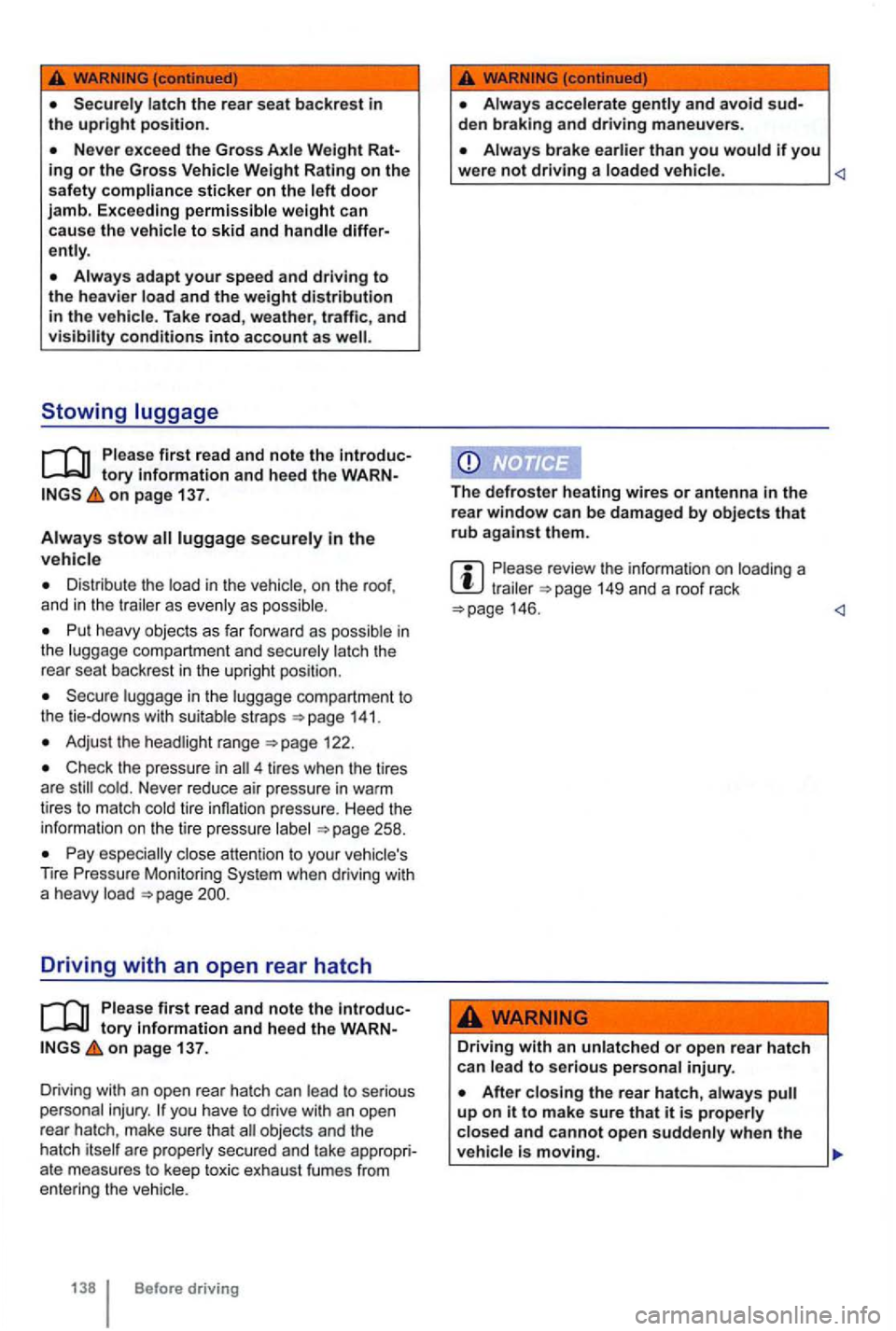
Never exceed the Gross Axle Weight ing or the Gross
Always adapt your speed and driving to
the heavier load and the weight distribution in the vehicle . Take road, weather , traffic, and visibility conditions into account as
Please first read and note the tory information and heed the on page 137.
Always stow luggage securely in the
Distribute the load in the vehicle, on the roo f,
and in the trailer as evenly as possible .
Put heavy objec ts as far forward as possib le in
the luggage compartmen t and securely latc h t he
rear seat backrest in the upright position .
luggage in the luggage compartmen t to
the tie-downs with su itable straps
Adjust the headlig ht range 122 .
Check the pressure in 4 tires when the tires
are
P ay especially close att enti on to your vehicle 's Tire Pressu re M on itoring
Driving with an open rear hatch
tory information and heed the on page 137.
D rivi ng with
an ope n rear hatch can lead to se riou s
personal injury. if you have to drive with an ope n
rear hatc h, make sure t hat objec ts and the
hatch it sel f are properly secured and take
Before d riving
den braking and driving maneuvers .
Always brake earlier than you would if you were not driving a loaded vehicle. <1
The defroster heating wires or antenna in the rear window can be damag ed by objects that rub against them.
Please review the in forma tion on loadi ng a tr ai le r 149 and a roof rack 146. <1
Driving with a n unlatched or open rear hatch
ca n lead to serious personal injury.
After clo sing the rear hatch, always
Page 240 of 516
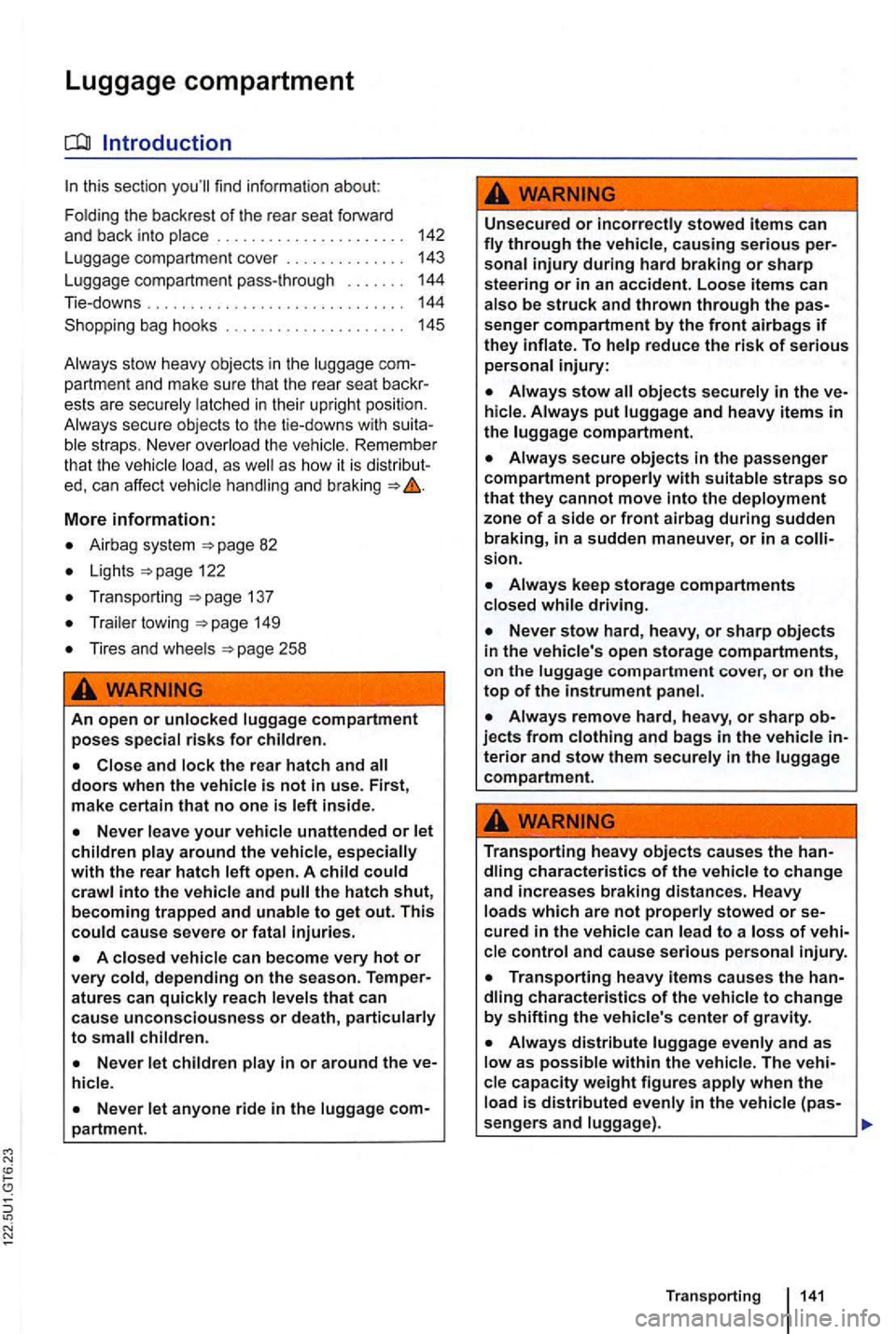
Introduction
this section
partment and make sure that the rear seat
ble straps. Never overload the veh ic le . Remember
t hat th e vehicle load, as as how it is ed , can affect vehicle
More information:
Airbag system
Lights
Transporting 137
Trailer towing 149
Tires and whee ls
An open or unlocked luggage compartment poses special risks for
atures can quickly reach levels that can cause unconsciousness or death, particularly to children.
hicle.
can
senger compartment by the front airbags if they inflate. To help reduce the risk of serious personal injury:
objects securely in the
sion.
jects from clothing and bags
Transporting heavy objects causes the
cle capacity weight figures apply when the
load is distributed evenly
Transporting 141
Page 248 of 516
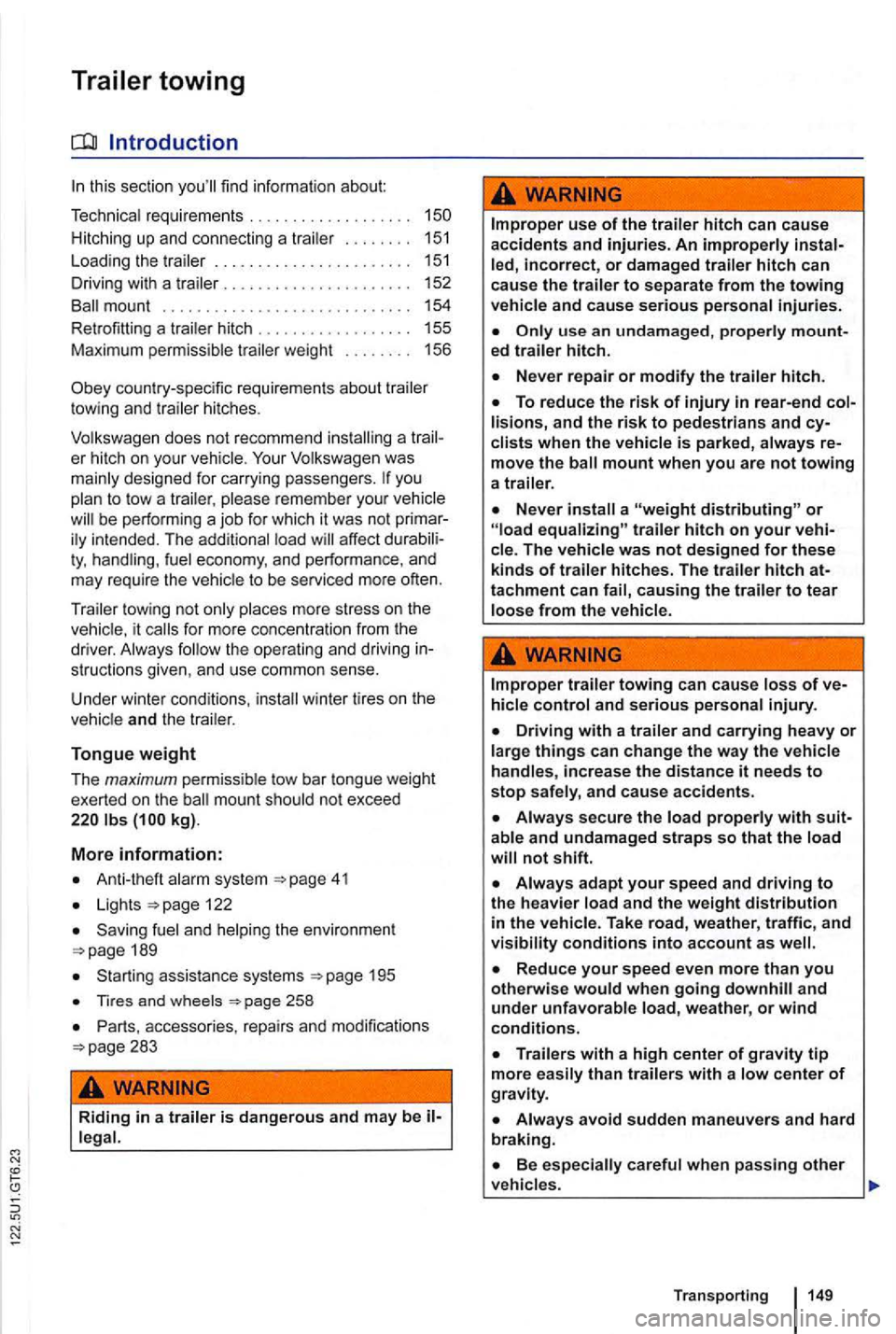
Introduction
this section
..
L oading the trailer
.............. ........ .
Driving with a trailer ..... . .. .. ........... .
mount .... . .
Retrofitting a trai l
er hitch ................ .
Max imum permissible trailer weight ... . 150
151
151
152
154
155
156
for
more concentratio n from the
dr iver . Always the ope rat ing and driving in
stru ctions given , and use common sense.
Un der winter conditions ,
win ter tires on the
vehicle and the trailer.
Tongue weight
The m aximum permissible tow bar tongue weight
exerted on the mount should not exceed kg).
More information:
Anti-theft a larm system
Lights page 122
Startin g assistance systems 195
Tires and wheels page 258
Parts, accessories, repairs and modifications
Riding in a trailer is dangerous and may be il
incorrect, or damaged trailer hitch can
cause the trailer to separate from the towing vehicle and cause serious personal injuries.
use an undamaged, properly mount
ed trail er hitch.
mount when you are not towing a trailer.
properly with suitable and undamaged straps so that the not shift.
and under unfavorable weather, or wind conditions.
careful when passing other vehicles.
Transporting 149
Page 249 of 516
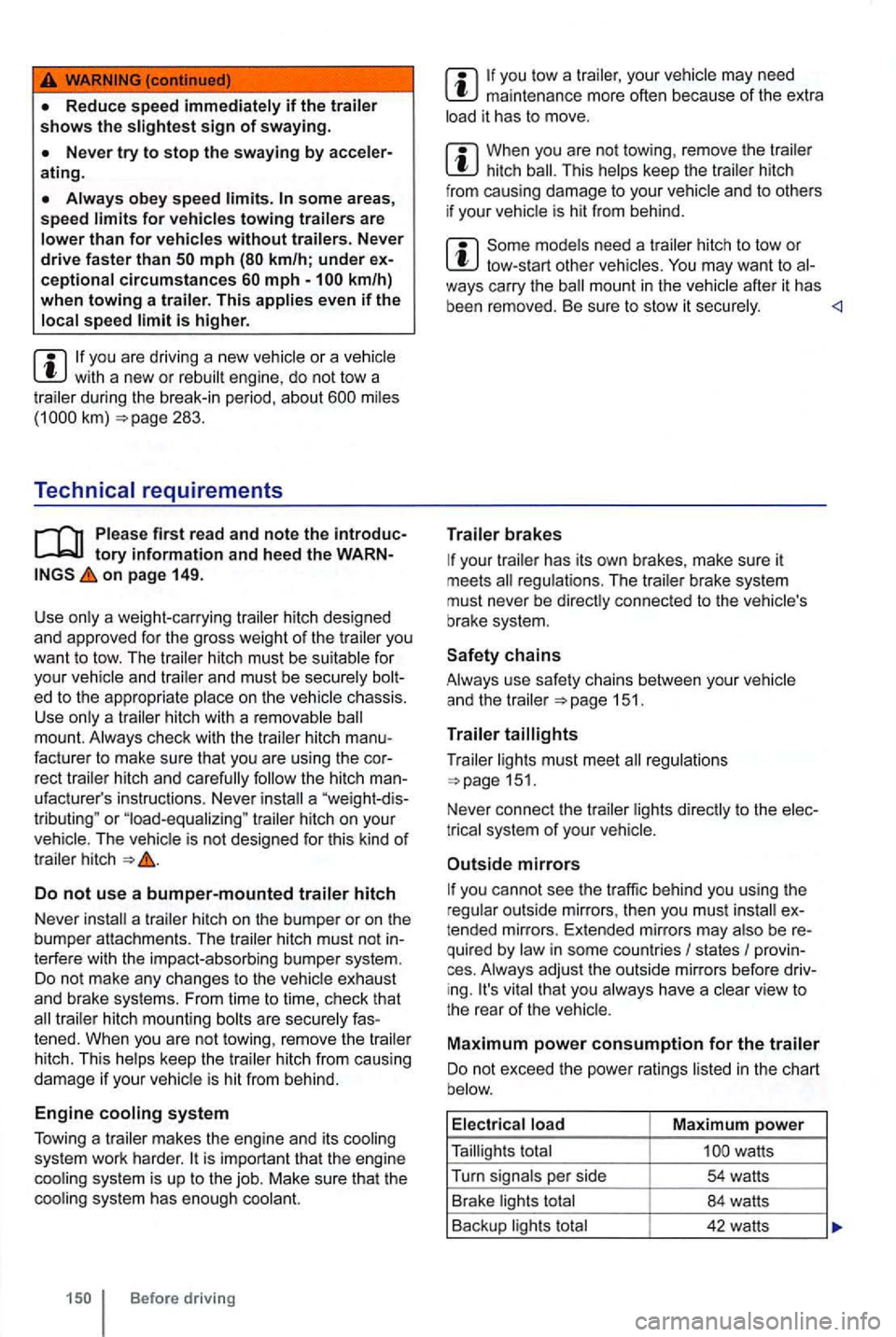
some area s, speed
is higher.
you are driv ing a new vehicle or a ve hicle with a new or rebui lt engine, do not tow a during the break-in period, about 283.
Technical requirements
tory informatio n an d heed the WARNon page 149.
Use only a weight-car rying
hitch must be suitable for
you r
a "weight -dis
tributing " or "load-equalizing " trailer hitch on your The vehicle is not designed for this kind of trailer hitch
Do not use a bumper-mounted traile r hitch
Never
a trailer hitch on the bumper or on the
bumper attachments. The trailer hitch must not in
terfe re with the impact-absorbing bumper system.
Do not make any changes to the vehicle exhaust
and brake systems. From time to time, check that trailer hitch mounting bolts are secure ly fas
tened. When you are not towing, remove the trailer
hitch. This
helps keep the trailer hitch from causing damage if your vehicle is hit from behind.
Engine cooling syste m
Tow i
ng a trailer makes the engine and its cooling
system work harder.
Before driving
maintenance more often because of the extra
load it has to move.
When you are not towing , remove the trailer hitch
Some models need a trailer hitch to tow or tow-start other vehicles. after it has
been removed. Be sure to stow it securely.
your trailer has its own brakes , make sure it
meets
151 .
T ra
iler
Trailer lights must meet regulations 151.
Never connect the trailer lights directly to the elec
t rical system
of your
Outside mirrors
you cannot see the traffic behind you using the
r egular outside mirrors, then you must ex
t ended mirrors. Extended mirrors may also be re
quired by law in some countries
I states I provin
ces . Always adjust the outside mirrors befo re dr iving. It's vital that you always have a clear view to
the rear of the veh icle .
Maximum po w er con sumption fo r the trailer
Do not exceed the power ratings listed in the chart
b elow.
E l
ectr ica l load Maximum power
Taillights total
Page 250 of 516
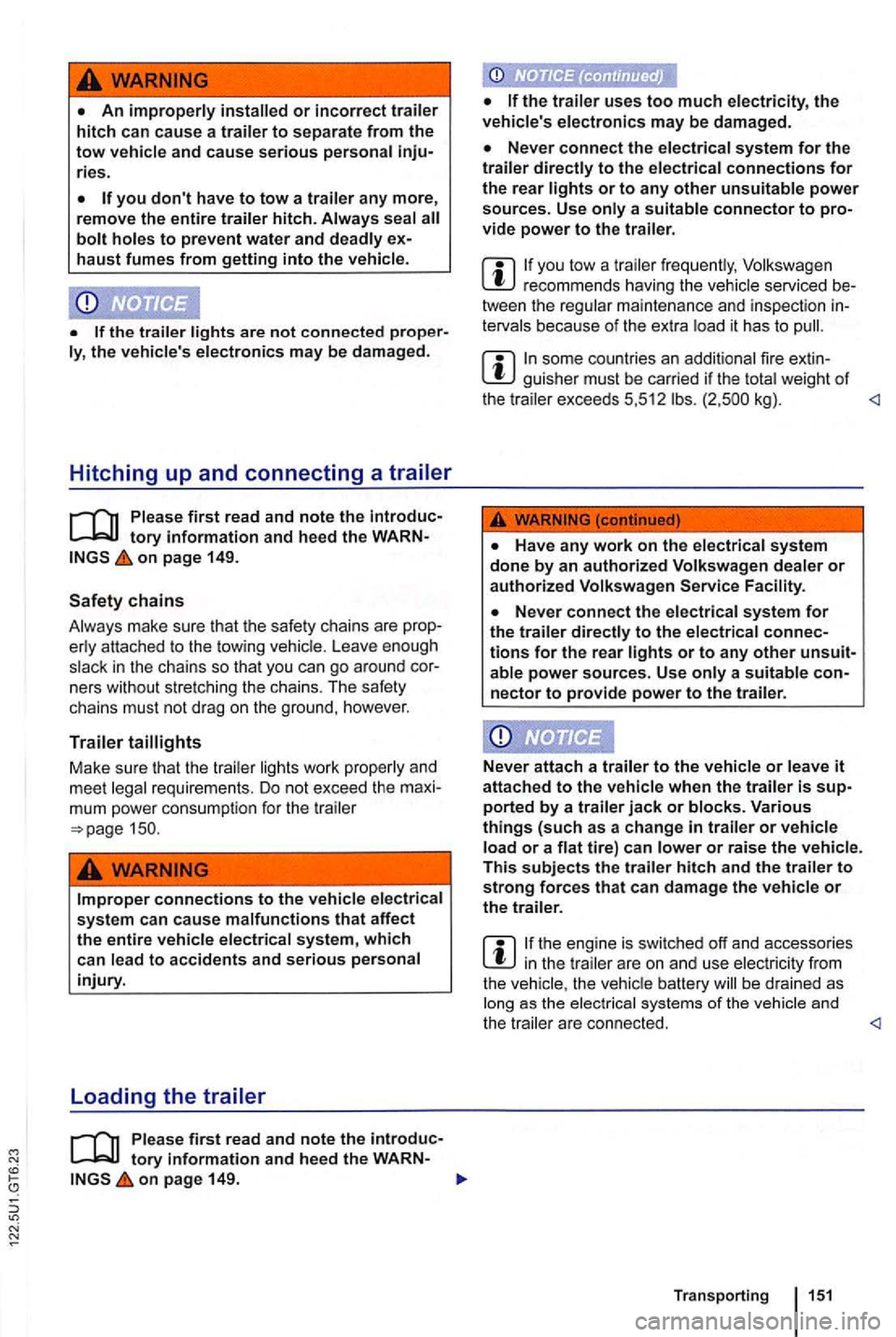
An improperly or incorrect trailer hitch can cause a trailer to separate from the tow vehicle and cause serious personal ries.
you don't have to tow a trailer any more, remove the entire trailer hitch. Always seal bolt holes to prevent water and deadly haust fum es from getting into the vehicle .
the trailer lights are not connected ly, the ve hicle 's ele ctronics may be damaged .
Hitching up and connecting a trailer
on page 149.
Safety chains
Always make sure t hat the safe ty c hai ns a re er ly attac hed to the tow ing ve hic le. Leave enough
s lack in the chain s so th a t yo u ca n go aroun d ners witho ut stre tc hin g the c hai ns. Th e safe ty
c h ai ns must not drag on the groun d, h owever .
Trailer
mum power consumptio n for th e traile r
connections to the vehicle electrical system can cause malfunctions that affect the entire vehicle electrical system, which can lead to accide nts and se rious personal injury.
Loading the trailer
tory information and heed the WARN -on page 149.
the trail er uses too much electricity, the vehicle's electronics may be damaged.
Never connect the electrical system for the trailer directly to the electrical connections for the rear lights or to any other unsuitable power sources. Us e only a suitable connector to vide power to the trailer.
if you tow a trailer freq uently, recom mends havi ng t he vehicle serviced
tervals because of the extr a load it has to pu ll.
some countries an addit ional fire guisher must be carried if the tota l weig ht of
the traile r excee ds 5 ,5 12 lbs. kg ).
Never attach a
trailer to the vehicle or leave it attached to the vehicle when the trailer is
things (such as a change in trailer or vehicle
load or a fla t tire ) can lower or raise the vehicle. This subjects the trailer hitch and the trailer to strong forces that can damage the ve h icle or the trailer.
the engin e is swi tc h ed off and accessories in the tr ailer are o n and use elec tricity from
the vehicl e, th e ve hicl e battery be drained as
l o ng as t he e lec trical sys te m s o f th e an d
the t railer are c onn ecte d .
Page 251 of 516
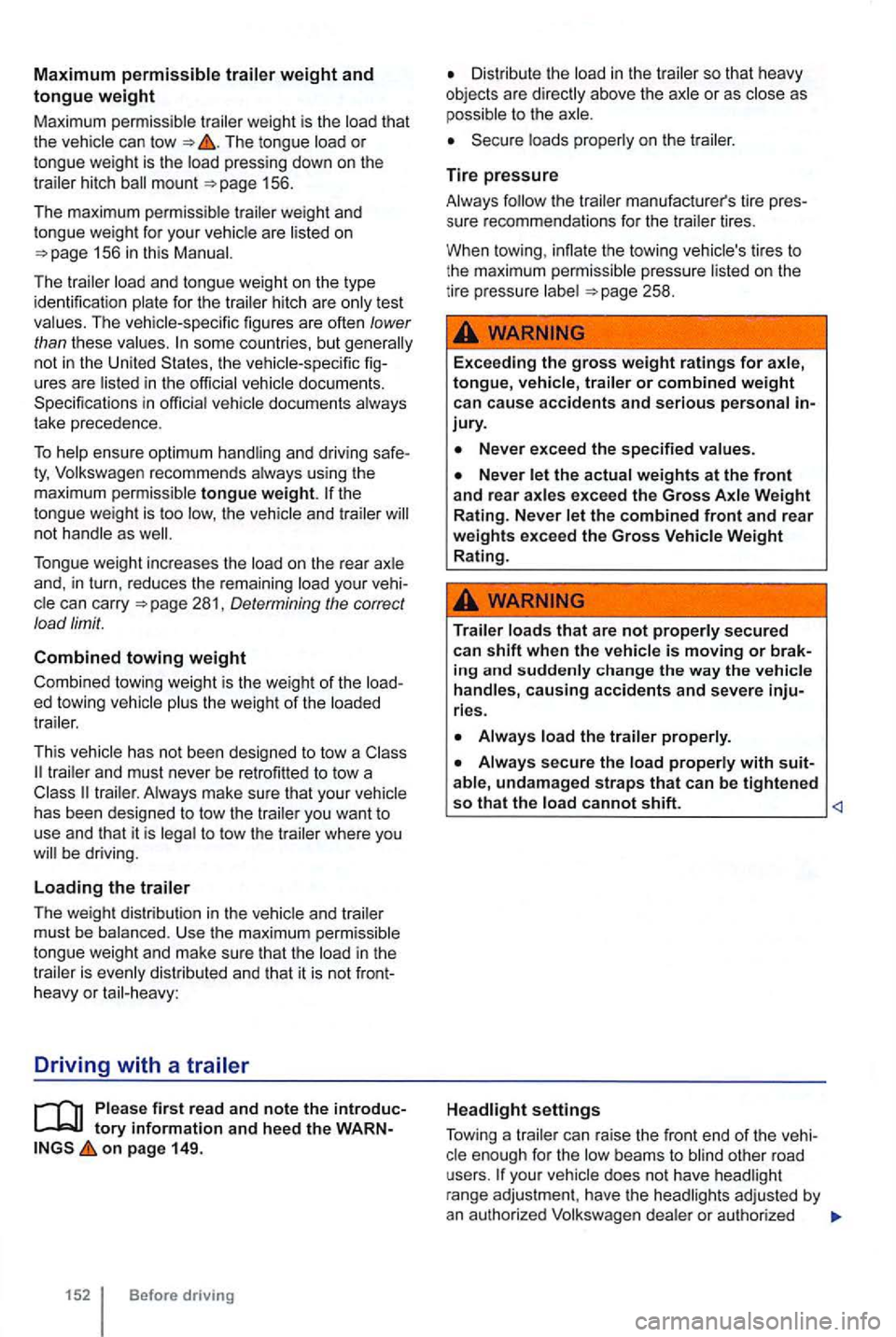
Maximum permissible
The tong ue load or tongue weight is the load pressing down on the
trailer hitch 156 .
T he maximum permissible trailer weight and
tongue weight for your vehic le are listed on
the vehicle -specific ures are listed in the official vehic le documents .
Spec ifications in officia l vehicle documents always
take precedence.
To help ensure optimum handling and driving ty, Volkswagen recommends always using the
maximum permissible tongue weight. the
tongue weight is too low, the vehicle and trailer will
not handle as well.
T ongue weight increases the load on the rear axle
and , in turn , reduces the remain
ing load your
trailer and must never be retrofitted to tow a
Class trai ler. Always make sure that your vehicle
has been designed to tow the trailer you want to
use and that it is legal to tow the trailer where you
will be driving .
Loading the
The weight distribution in th e vehicle and traile r
must be balanced. Use the maximum permissible
tongue weight and make sure that the load in the
trailer is evenly distributed and th at it
is not heavy or tail-h eavy:
Driving with a trailer
on page 149.
152 Before driving
Distribute the load in the trailer so that heavy
objects are directly above the axle or as close as
possible to the axle.
258.
able, undamaged straps that can be tightened so that the load cannot shift.
Towing a trai le r can ra ise the front end of the